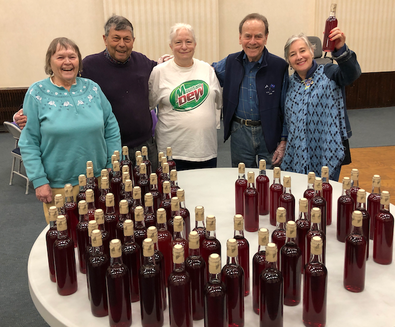 A Tale of the Grape Last year, the single grape vine in Temple Sinai's Biblical Garden produced 13.2 ounces of grapes. Rather than eating them, we incorporated them in a wine producing project. Participants included myself, Sherry Feldman, Stan Horowitz, Phyllis Solod, Cantor Deborah Johnson, and Bob Serinsky. We purchased three boxes of merlot grapes which we de-stemmed and crushed into wine. In February we bottled the wine producing seventy 375 mL bottles of red table wine and 40 mL bottles of merlot. We are scheduling a wine and cheese fundraiser with the minimum contribution set at $8 for the table wine and $16 for the merlot. We believe that our wines will be received with great reviews. Look for the posting in the Rabbi’s “See What’s Happening” email. Biblical Garden Status The Torah lists seven species that are regarded as special to the Land of Israel (Deuteronomy 8:8). They are pomegranate, fig tree, grape, wheat, barley, honey and olive. We have planted as many of these as we can in the garden. If you walk through the garden you will see various plants starting to emerge. Daffodils and garlic are first up. They were planted by our Religious School's 7th graders. This year, we are also planting barley, flax and wheat. Flax seeds take about 100 days to mature and will produce little blue flowers and pods which will contain edible flax seed. (You do not have to go to Whole Foods to buy flax seeds. We will have them straight from our Biblical Garden). Using the stems, we can make flax thread. I'm not sure what I will do with the wheat and barley; maybe we will make beer. When we harvest the garlic, Egyptian onions, and potato onions, we plan on using some for the Shabbat morning Torah study breakfast. The rest will be donated to the Kosher kitchen. The horseradish root which I planted last year will be dug up and harvested to create the bitter herb for Passover. We'll replant a small portion of the root to provide more for Passover 2021. As we did last year, we will plant various herbs mention in the Torah such as mint, marjoram, sage, etc. to be used either at the Shabbat morning breakfast or the Kosher kitchen. We'll plant flowers in the planters throughout the garden. We also have a honey bush planted by my predecessor, Catherine Walters, and that will serve as our substitute for honey as being easier to care for than an actual bee hive! Last year, I planted a pomegranate tree near the grape vine, and I am hopeful that it will come up. I also bought an olive tree and it is thriving in the sunroom of my house under a grow lamp. When all chances of frost have disappeared, right after Mother's Day, I will bring out the olive tree and place it in the Garden. At about the same time, I will unwrap the fig tree. It presently is wrapped in insulation with a pipe to provide air and vent away moisture. A gardener from a synagogue in Hartford, Connecticut, contacted me after reading this blog for a tour of our Biblical Garden and assistance in reviving their garden. It's nice to be recognized! If you feel the garden urge, help is always welcome. I cannot detail the pleasure one experiences in growing food, herbs and flowers.  After the High Holy Days, on Sunday, October 27, we will be making wine in the synagogue’s kitchen. I have ordered three 36-pound boxes of grapes which – when added to the grapes from our Biblical Garden (13.6 ounces) – will make more than six gallons of wine. That will be enough for approximately 70 half bottles. Making wine is a five-step process: crushing the grapes, placing them in a fermenter with yeast for about a week (called "primary fermentation"), siphoning the wine into a glass vessel to allow residue to settle out for three to four weeks (called "racking"), aging the wine, and lastly, bottling. The wine should be ready for consumption by the late spring 2020. I have arranged through a friend of mine to use his grape press to crush the grapes. But to crush the grapes, volunteers are needed to de-stem the grapes plus work the grape press. Ten volunteers are needed. If interested, please contact me. We plan to start at 2:00 pm on October 27th. Please wear old clothes since at times it can become a little messy. It will take about two hours. Sorry, there are not enough grapes to do it the “Lucy and Ethel” way by stomping on the grapes with bare feet. For bottling, I will need several volunteers to wash the bottles and fill them. After bottling, we shall hold a wine tasting with cheese and crackers with bottles distributed to the congregation on a first-come-first-served basis. By law, the wine cannot be sold, but contributions can be made in advance to the Temple Sinai Wine Fund! Other News from the Biblical Garden Everything planted with few exceptions has grown and thrived. The produce I planted – potato onions and bush beans have been harvested. They will be distributed to a local food pantry. The herbs planted – mint, coriander, sorrel, fennel, sage, rosemary, marjoram, hyssop, sorrel will also go to a place where they will help people. The horseradish root has produced leaves and, come Passover 2020, the root will be dug up and a portion of the root will be sliced off. This root piece will then be cut up for bitter herbs for the Seder. Then, the horseradish root will be replanted for use in 2021. The willow tree is a graft with the willow portion grafted onto a mother tree. The mother tree decided to send shoots through the willow branches; they have been removed. So, now the willow graft is thriving. Thanks to Rabbi Jeff, I have been in contact with various biblical gardeners and they have help me identify plantings done by Catherine Walters, ז׳׳ל. I've also benefitted from their expertise in learning to tend our garden. In the fall and spring I plan to incorporate the seven species set forth in Deuteronomy – pomegranate, wheat, barley, olive, honey, fig and grape. In the garden, we already have a fig tree and grape vine. Two of my neighbors are beekeepers and I planned to borrow a hive from one of them to install on the Temple grounds. I tried to plant wheat and barley, but failed because I planted them too late. Early next spring, I will plant these two crops plus flax. The pomegranate tree and olive tree have been ordered. During the winter, the olive tree will be grown in a planter which will be kept inside during the winter and outside in warm weather. I also plan to plant myrtle, garlic and crocuses this fall. Next year I will continue planting bush beans and onions to be distributed to a food pantry. 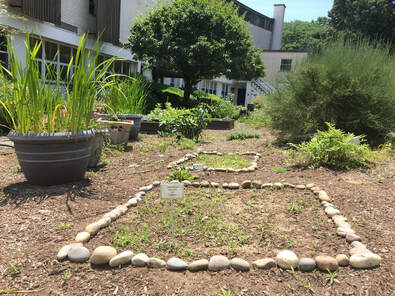 Let me introduce myself. I am Michael Schlesinger, a newbie to Rhode Island having arrived in 2012. I used to be a member of Temple Am David until it closed. I have been a member of Sinai for two years and I am very happy here. I am a Friday night davaner, I attend Saturday morning Torah study, and I go to the Rabbi’s Tuesday morning adult education classes. When the Rabbi put out the call for assistance with the Biblical Garden, I answered together with Sherry Feldman. Sherry decided that she wanted me to be the lead gardener with her as my assistant. I have surveyed the Biblical Garden created by Catherine Walters, ז׳׳ל, and it is fascinating to see the plants, bushes and flowers she installed. I would have loved to have met her. I have some background as a gardener. I was born before WWII and my mother had a Victory Garden until I was about eight years old. She grew a number of vegetables and I helped her. Every house that I have owned has had a garden. When I lived in California, I had a small vineyard (32 vines) and the wine produced, in a word, was “eh.” However, a friend of mine had a real working vineyard of several acres and I used to help him with his vines. The wine we produced was very good. My neighbor, Bill Baddely, across the way from my house on Ocean Avenue in Cranston is a URI Master Gardener. I have asked if he could assist me with the Biblical Garden and he, together with his wife Jackie, are my consultants. After reviewing the garden with me, he suggested that we grow wheat and barley. Bill advised that he had some wheat seeds. Dottie from Sinai ordered some barley. You will now see two patches near the sidewalk in our Biblical Garden, about four square feet each, where we have planted these. The one closest to the walk is wheat and the one behind is barley. Bill also supplied flax seeds and the seeds have been planted in the patch near the crab apple tree. After a consultation with Bill, we are also planning on planting a dwarf apple tree in the mound next to the grape vine. There is a fig tree in the garden, but it is a kind that cannot survive our winters. So, on Bill’s advice, we are seeking a Chicago Fig Tree. Before we do any planting, we are going to test the soil to ensure that the trees will be able to survive and produce fruit. Speaking of the grape vine, you will note that it is producing leaves and grapes. On May 1, I trimmed the grape vine so the number of wine shoots would be minimized. The reason for this is that you do not want a vine pumping out leaves; you want it to grow grapes. Also, when the leaves on a shoot reach 15, you cut off any leaves afterwards; again to produce good grapes with lots of sugar and if there are too many grapes on the vine, then the quality of the bunches decreases. When the vine is producing grape bunches, I will cover the vine with netting in an attempt to keep the birds from eating the grapes. In the fall, we will harvest the grapes and make wine. (I will supplement the crop with grapes which I will purchase from my wine supplier.) When we are harvesting the grape bunches, I will give a brief lecture on growing wine grapes. More on this later. If anyone wants to install a vineyard on their property, please contact me. You will notice that I removed the weeds in the planting boxes. In one box, I transplanted all the Egyptian onions and it looks like they are thriving. Egyptian Onions are called “walking onions” and, if you looked at the garden before I did some weeding, you would have understood how Egyptian Onions reproduce themselves by literally walking through the garden. I also planted some potato onion bulbs in the same box as the Egyptian onions and some bush beans in the other planting box. Shoots should emerge soon have emerged and they are thriving. I also planted a horseradish root, so, come Passover, we will have our own supply of bitter herbs. The next blog entry will describe additional plantings and activities. For starters, besides making wine, we are going to harvest the wheat and barley to make bread. Of course, we will have to add flour, but we will address the bread making as we approach harvest. It is my goal to involve the congregation in harvesting and making wine and bread plus sharing the bounty of the garden with them. I will endeavor to only use organic materials in the garden – organic mulch, fertilizer and weed spray. If you have questions or comments, speak to me when I am at Sinai. Mike Schlesinger 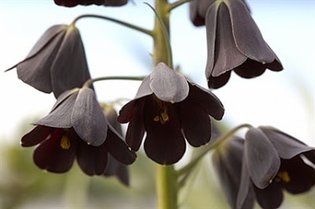 Persian Lily in the Biblical Garden Persian Lily in the Biblical Garden I went down to the nut orchard to look at the blossoms of the valley, to see whether the vines had budded, whether the pomegranates were in bloom. Song of Songs 6:11 In the Biblical Garden, the seven year old almond tree has leafed out abundantly and bloomed for the first time. The grape vine has budded in its second season on the arbor, and the dwarf pomegranate, now outdoors again, is ready to gift us with more of its tiny orange flowers and miniature fruit. The spring color-riot of early flowers continues: narcissus, brilliant blue grape hyacinth, petite red cups of wild tulips, and (new this year) elegant Persian fritillary bells in gorgeous purple, all have bloomed and faded. Iris and poppies are in full display. Now we watch for awakening of the fig tree which sleeps late each year, in the hope and expectation that it survived another winter. In May we assessed what we have gained versus what was lost or damaged due to the cold, and what to transplant, divide, and replace. We delight in “volunteers,” new plants self-seeded from last year’s ripened bounty: lupines and globe thistle, nigella and chamomile. Religious School students have been busy in the garden, cleaning up, cutting back overgrowth, and patrolling for dandelions. Seventh grade gardeners planted cucumbers, grains and lentils, and started herbs in the raised beds – this year: dill, borage, fennel, parsley. The 6th grade class secured fallen branches to the A-frame structure so the peas they have planted can climb. They have started seeds of sorghum (broom corn) which produces seed heads on stately canes 8-10 feet tall. In addition they planted chickpeas as they snacked on hummus and compared ingredients and recipes for that Middle Eastern staple. Todah rabah (many thanks) to Nate Finstein, Roxanne LaCroix, Sherry Feldman, Herb Katz, and Lily Wolfgang, along with teachers Sue Oclassen and Suanne Goodman, for helping to create another garden experience for our students. As we nurture soil, plants and community, a garden is where we might meet nature half-way, on that “middle ground between the lawn and the forest,” as author Michael Pollan observes in Second Nature. It teaches respect for, and cooperation with the natural processes that enable us to live our lives on our local patch of ground, and it encourages us to be mindful of our human place in the sacred community of life on Earth.  Every spring in the Biblical Garden, religious school students sow two strains of ancient wheat, einkorn wheat, the ancestral mother of all wheat, and emmer wheat, the genetic source of modern wheat varieties. Wild einkorn often survives in sandy or rocky soils where other varieties of wheat fail. Emmer wheat has a higher yield with fatter kernels and more nutrients than einkorn. Rich in gluten, it was the variety commonly grown for bread-making throughout the eastern Mediterranean region and in Egypt during the Israelite sojourn there. The “bread of affliction,” the unleavened dough which the Israelites, in their haste, carried on their journey from slavery to freedom, was made from emmer wheat. Indigenous wild wheat grows today in the rocky soil of the Galilee and Golan Heights. The genetic sources of modern bread wheat stem from these ancient grains. In our day, wheat provides 20% of the calories and proteins consumed around the globe. The impacts of population growth, political instability, and climate change are of urgent humanitarian concern. Scientists are investigating ways to improve the hardiness, nutritional value and yield of modern wheat as one way to address the hunger that stunts the lives of millions of children and adults. Much of this work is being done in Israel. The Wild Cereal Gene Bank at the University of Haifa’s Institute of Evolution provides a gene pool of over 3,000 wild wheat samples, sourced mostly from Israel. Scientists use this material in searching for useful genes that can be cross-bred into domesticated wheat to improve drought and disease resistance, protein content, and adaptability to varied soils and rainfall levels. When we gather at our Passover seder tables, we raise our matzah, our “bread of affliction,” and read: “let all who are hungry come and eat.” We invite those who hunger to join us and be filled, and to hear the Passover story of our liberation from bondage in Egypt. Conditions of bondage continue to exist, as people in our community and millions more in our wider world struggle with food insecurity every day. The Passover message applies not only to this one night that is different from all other nights, but in every night when someone, somewhere goes to bed hungry. We can do more to support the local agencies and organizations that glean excess farm produce, collect and distribute unsold food from markets, operate food banks and supply soup kitchens. We can support organizations, such as Mazon, which advocates for the hungry and works to strengthen food and nutrition programs at the local, state and national level. We can enrich our Passover experience by being aware that our tables, laden with abundant and nutritious food can be shared through tzedakah and through actions that help meet the basic need for sustenance in our human family. 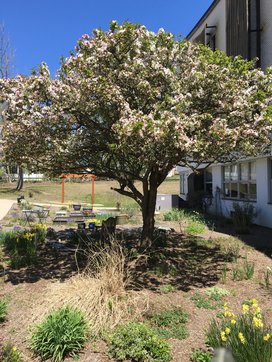 Rabbi Yohanan Ben Zakai said: "If you have a sapling in your hand and are told that the Messiah has arrived, plant the sapling and then go to greet him." Avot of Rabbi Natan B, chapter 31 In this month falls the minor holiday of Tu BiShvat (the 15th of Sh'vat), the “New Year for Trees,” in which Jewish tradition asks us to pay special attention to trees and ecological concerns both in Israel and the wider world. Many people now consider it to be the Jewish equivalent of Arbor Day, a day on which to celebrate nature and reconnect with the earth. In Israel it has become the national tree planting holiday, part of the decades-long effort to create productive land from desert and swamp. Many communities, including Temple Sinai, conduct a Tu BiShvat Seder, which is said to have been created by Rabbi Isaac Luria of S'fat. Modeled after the Passover Seder, the ritual gives special meaning to the fruits and trees of Israel. We enjoy eating fruits and nuts that grow in Israel, such as olives, dates, figs, apricots, almonds and walnuts, and we drink four cups of wine with appropriate blessings. In the Biblical Garden, the fig tree, now wrapped under burlap for the winter, the grapevine and the almond tree now wait in anticipation of spring. The dwarf olive and pomegranate trees are in residence on a kitchen counter for the winter. And in the sixth grade Religious School classroom, a planter sits in a sunny window with over a dozen soil-filled paper cups. Emerging from the soil are little etrog (citron) trees planted two months ago, the yield of an etrog that was used in our Sukkot festival celebration last fall. Some will soon go home with students, and a couple will become Biblical Garden specimens, the “fruit of goodly trees” referenced in Leviticus 23:40. It’s a simple activity, to cut open a fruit, enjoy the marvelous citrus scent, pick out seeds from the pulp, plant and water them. As students cultivate seeds in the classroom and soon in the garden, they may also cultivate within themselves a more intimate connection with nature, and discover that their actions can make a difference: they can fully participate in the work of tikkun olam – repair of the world. This year, the Tu BiShvat Seder at Temple Sinai will be held on Friday evening, February 10, at 7:00 PM following the 6:00 PM Shabbat evening service. Enjoy a blog post by Rabbi Jeff Goldwasser on Tu BiShvat at this link. 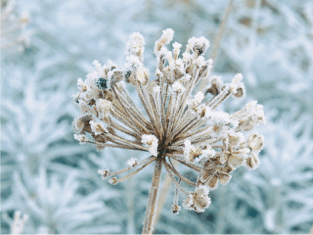 From the rising of the sun unto the going down thereof the Eternal One’s name is to be praised. Psalm 113:3 In these dark days, plants in the Biblical Garden lie bare, skeletal, with hollow stems and brittle, desiccated remains of leaves littering the frozen ground. Seed-heads are scattered across the waiting earth, their promise of new life at rest until brighter days awaken their life-force, and their pods or seeds split open under the warmer rains of spring. The bitter wind rasps the branches of the almond tree and the willow. The essential structure of the garden lies hidden beneath the snow and no visitors come to sit on the bench and listen to the birds chattering among themselves about nest-building days to come. Once again it’s that liminal season when all is quiet, and as the daylight hours gradually lengthen, we reimagine what the garden can be in the growing season ahead. Do we want to re-establish the dye-plants whose color-laden roots and blossoms made Joseph’s coat so vivid? Do we want to set aside a plot for wild plants we know as weeds, but which served as forage for Abraham’s flocks and added flavor to the stewpot bubbling on Sarah’s hearth? And should we relocate the Stachys byzantina, the lamb’s ear plants, with their soft, wooly leaves which were petted by third-grade Religious School students during last autumn’s exploration of the garden? The Biblical Garden is a world of possibilities. To bring those possibilities to fruition, first comes observation and evaluation of the garden that was, then a plan takes shape to realize the “garden to be” in the longer days ahead. We can be grateful for this waiting season as we dream and imagine and plan for the warmer days to come. While the garden is designed to be relatively low-maintenance, all gardens need an occasional helping hand. If you like to work with plants and can spend a couple of hours planting and tidying up this spring, please contact Catherine Walters at 401 419-7698, or [email protected].  When Elisha returned to Gilgal, there was famine in the land. As the company of prophets was sitting before him, he said to his servant, "Put the large pot on, and make some stew for the company of prophets." One went out into the field to gather oroth and found a wild vine and gathered from it his lap full of wild gourds and came and cut them up into the pot of pottage, not knowing what they were. The stew was poured out for the men, but as they began to eat it, they cried out, "Man of God, there is death in the pot!" And they could not eat it. 2 Kings 4:38–40 The biblical oroth is garden rocket, an annual in the mustard family. Rocket, Erica sativa, flourishes in the hilly areas of Israel and throughout the Mediterranean. Also native to the salad aisle in the supermarket, we may know it as arugula. Buds, flowers and leaves were used as potherbs by pastoralist communities in ancient Israel. As with rocket, greens such as dandelion, wild carrot, dock, purslane and sorrel provided forage for flocks and herds, and were gathered for “pottage” (vegetable stews). Something, however, is clearly amiss in the vegetable stew at Elisha’s hearth; the “death in the pot” was likely the wild gourd, Citrullus colocynthis, or bitter apple. A member of the watermelon family, it’s a ground-hugging vine which grows abundantly in dry conditions and bears round, yellow fruit with green spots and poisonous pulp. When consumed, it can be a violently purgative agent. Foraging for wild vegetables is a basic survival skill that has long been forgotten in this age of large scale agriculture. Now that our modern diet relies on white bread, burgers and other processed foods, these wild potherbs, once relished, are marginalized. We view them as weeds, because they are hardy and tenacious, growing along roadsides and popping up in lawns. But edible wild plants added robust flavor and valuable nutrients to the biblical diet. A source of vitamins A and C, rich in calcium, iron and potassium, they can be found in the Biblical Garden. Elisha’s stewpot reminds us that it’s best to know what’s in our salad and our pottage before we eat it, as his company of prophets regrettably discovered.  "And God said, 'Let the earth bring forth grass, and herb yielding seed, and the fruit tree yielding fruit after his kind, whose seed is in itself, upon the earth': and it was so." Genesis 1:11 November again, the days are shorter, the air is chill. In the ripeness of autumn, plants have gathered a last burst of energy to produce seed and fruit for growing seasons to come, gifts for the future. It’s time to put the garden to bed for the winter, to remove the tall, stately stalks of Sorghum bicolor (broomcorn), cut back the brown, brittle stems of the sunflower, valerian, and mallow. There is beauty in the remains of summer’s rampant growth, evidence of lives fully lived, of completion, of shalom. Seeds are collected to replenish the seed basket for next spring’s planting – barley, cleome, lupine, calendula, and pulses. The fig tree and the grape vine will be wrapped in burlap to protect tender branches from drying winter winds. Religious school students will lend a hand with the chores that maintenance of the garden requires. This year there is a new task: gathering up the bulbs of the brilliant red Anemone coronaria, in Hebrew, kalanit, to be stored for the winter. Anemones carpet the northern Negev region of Israel in the spring and their blossoms are breathtaking in intensity of color and perfection of form. In the Biblical Garden, however, they require patience and persistence. After several seasons of unsuccessful attempts, fresh bulbs were planted by religious school students this past spring, and were (finally) brought to bloom in one of the raised beds. Perhaps the brightest of the “flowers of the field," they are members of the buttercup family, and, when encountered, elicit exclamations of awe and delight. Those who discovered them blooming in mid-summer, nestled among unruly tangles of cucumber and melon, might have stored up images of their vivid scarlet, to be recalled in the chill, grey days of winter to come, memories that refresh the spirit and warm the heart. 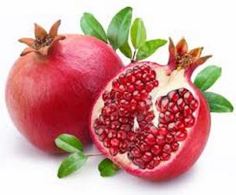 He made pomegranates in two rows encircling each network to decorate the capitals top of the pillars. He did the same for each capital. 1 Kings 7:18 The pomegranate (Punica granatum) is a small, bushy tree that grows about twenty feet high. Originally native to Iran, it travelled along some of the same trade routes that would later be associated with the silk trade, and spread across much of the ancient world. One of the seven species of agricultural products associated with the Land of Israel, the fruit is a symbol of righteousness, because it is said to have 613 seeds representing the 613 commandments of the Torah. (The actual number of seeds varies, of course, with each fruit.) Pomegranates, in Hebrew rimonim, adorned the tops of the pillars in Solomon’s temple, and ornamented the robes of kings and priests. The fruits represent fecundity and, indeed, life itself; with their abundance of seeds and intensely red juice, they are messy, fragrant, sweet, and tart. The pomegranate in the Biblical Garden is a dwarf variety that blossoms and grows lovely miniature fruits. Not winter-hardy in New England, it’s grown in a container and brought indoors after Sukkot. Pomegranates are traditionally eaten on Rosh Hashanah by Jews all over the world as a symbol of abundant goodness and in the hope that the Eternal One will grant us health and happiness in the coming year. Before the fruit is eaten, this blessing may be said, “May it be Your will, Lord our God and God of our forebears, that our merits increase like the seeds of a pomegranate.” |
AuthorsMichael Schlesinger is Temple Sinai’s Biblical Gardener. Mike has been gardening since he was eight years old. He used to grow grape vines and make wine when he lived in California. He now tends to our garden, continuing the traditions started by Catherine Walters. Archives
March 2020
|

Affiliated with the Union for Reform Judaism
30 Hagen Avenue • Cranston, RI 02920 • 401-942-8350 Office: dottie@templesinairi.org Rabbi Jeffrey Goldwasser: [email protected] |
Want to sign up for the weekly Sinai Scroll email?
Click here to receive weekly updates on Temple services, events and a message from the Rabbi. |


